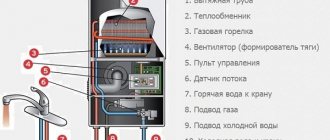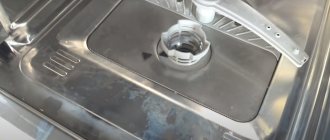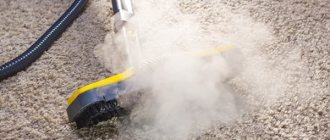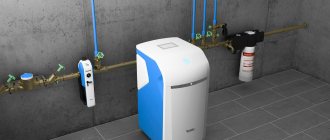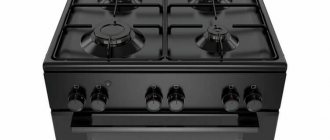Geyser - principle of operation, causes of clogging
A instantaneous gas water heater is essentially a heat exchange device. Its main element is a special pipe circuit. A water stream flows through it and is heated by an open external flame of a gas burner. Modern models turn on automatically - as soon as the mixer valve opens, ignition occurs and thermal energy is transferred to the walls of the circuit, and from them to the flow. As a result, the user receives hot water at the outlet.
Despite the simplicity of the design and operation scheme, the operation of such a device constantly creates harmful factors that interfere with normal functioning - first of all, these are:
- Carbon deposits are on the outer walls of the heat exchange circuit. It impairs heat transfer from the burner to the water, reduces efficiency, and leads to excessive fuel consumption.
- Scale – builds up on the inner walls of the heat exchanger. It is formed as a result of the decomposition of salts dissolved in water and the precipitation of a solid insoluble precipitate. Reduces flow, reduces pressure, impairs performance.
Scale build-up in the heat exchanger significantly reduces the performance of the heater Source bigam.ru
- Soot - solid products of gas combustion inevitably settle on the burner itself and the igniter. The flame periodically goes out, the combustion intensity decreases, performance deteriorates, and there is a risk of gas leakage.
In addition, depending on the quality of the water, other impurities may settle in the heating device - rust, silt, sand, etc. To eliminate their influence, periodic and timely proper cleaning of the gas water heater is required.
Gas water heater cleaning products
The rules for caring for a gas water heater are described in detail in the instructions for the device, and deviating from these requirements can be dangerous. If the water heater suddenly becomes clogged, you should use only products recommended by the manufacturer to clean it. They should also be indicated in the relevant paragraphs of the instruction manual. And it is better to entrust the cleaning process to professionals. In this case, not only will the blockage be eliminated, but the warranty will also be preserved.
Important ! Unauthorized reading using unauthorized means is dangerous to health! If during the process of descaling or burning one of the elements of the column is damaged and a gas leak appears, you must immediately call 104.
Only if the user understands all the possible consequences and accepts responsibility can he clean the device himself. What and how to rinse a geyser (for example, Ariston brand) from scale in this case? You can also use ready-made drugs or traditional methods. What is better and more effective: “vigorous” chemistry or “grandmother’s” cleaning, the comparison table will show:
| Solves the problem | Folk remedy | Chemical drug |
| Scale inside the heat exchanger | A mixture of 0.5 liters of hot water and 100 g of citric acid. | Calgon or Antiscale (corrodes layers of scale inside pipes). |
| A dense layer of carbon deposits (can only be removed from the heat exchanger; the gas part is cleaned by specialists) | Dilute table vinegar and warm water in a ratio of 1:3. | You can use 7-10% hydrochloric acid or other strong chemicals. Important! The work requires care: under no circumstances should the product come into contact with the skin or mucous membranes. |
Signs you need cleaning
The primary symptoms that the device is clogged and needs urgent cleaning are the following:
- The pressure of hot water is noticeably lower than that of cold water. Occurs due to a narrowing of the pipe lumen as a result of overgrowing with deposits.
- There is a regular shutdown of the device immediately after startup. The reason is the formation of carbon deposits on the ignition element.
- The level of water heating has decreased while the power of the device remains unchanged. It is a consequence of external fouling of the heat exchange circuit by carbon deposits.
- The time for heating water to the set value has increased. Occurs due to a decrease in burner flame power.
When the heat exchanger is clogged, the water flows extremely slowly and hardly heats up. Source cosmo-frost.ru
- There is noise inside the device during operation. Extraneous sounds are a consequence of uncharacteristic boiling of water inside the heat exchanger due to loss of sensitivity of contact thermal sensors with the walls of the thermal circuit.
- Switching off the device upon command from thermal protection sensors. Due to scale build-up, the walls of the heat exchange circuit begin to overheat.
In addition, when the heater is turned on, a strong bang may occur, indicating that the burner ignition is not working properly, and soot may simply begin to fall out from under the housing. All these signs indicate an urgent need to clean the gas water heater. Otherwise, the situation may get out of control, which will lead not only to damage to the device, but also to a leak of household gas with the ensuing serious consequences.
Important! Before starting cleaning procedures, the instantaneous water heater must be disconnected from the water and gas supply.
Before starting cleaning work, be sure to turn off the water and gas supply Source baltgaz.ru
Where is the filter located in the gas water heater? How to remove soot from a heat exchanger
We wrote above where the heat exchanger is located; before starting maintenance, it is advisable to remove it from the unit, first turning off the gas and water, opening the tap for supplying hot water (the one located near the flow-through heater). Then, using a gas or open-end wrench, loosen the nut securing the tube to the water unit and unscrew it slightly (a couple of turns will be enough). The contents must be allowed to flow out through the mixer, which is left open.
Helpful advice. Before cleaning the geyser from scale, prepare a special tool and products. The most convenient way to solve the problem is to use an aerosol agent to loosen boiled threaded joints. You can ask for the WD40 product at any auto store or hardware store.
How to clean the geyser heat exchanger further:
- Unscrew a couple of union nuts and dismantle the assembly.
- Disassemble other elements and parts that prevent easy dismantling. Their number depends on the specific model and design features of the column. In some cases, it is necessary to remove the smoke exhaust diffuser, in others - the ignition group, in others - overheating and draft sensors. You may have to remove all the parts.
- Cover the burner nozzles with a cloth to prevent soot from getting into them.
- Take the heat exchanger to the bathroom, thoroughly clean it with a long-bristled brush to remove all soot, rinse and dry.
- Return the unit to its place and reassemble the unit in the reverse order described above.
Do not forget to install new seal rings at the pipe connections. Cleaning a geyser is not difficult; most of the time is spent on assembly and disassembly. Work must be carried out strictly according to the rules. If you are not sure that you will do everything as needed, call a specialist.
Helpful advice. If the installation is clogged, you have already removed the heat exchanger, it makes sense to immediately rinse and clean the gas water heater from scale. Maintenance will be more efficient and will not take much extra time.
Before starting the unit, you need to check it for leaks. To do this, open the water supply tap and wait until the heat exchanger is filled from the open mixing tap. Then the supply is closed again, and the unit is inspected to determine the degree of permeability of its connections. If there are no serious problems, the gas valve is re-opened and the apparatus is started up for testing in standard operating mode.
Use liquid for flushing and softening connections during maintenance at your discretion. Chemistry simplifies the work, but it is not necessary to use it.
Flushing helps not only from carbon deposits, but also from dust.
Features of cleaning main components
In domestic conditions, the owner of a gas instantaneous water heater is allowed to clean the following main parts:
- The burner surface is free from soot and deposits.
- Heat exchanger against scale build-up.
- The surfaces of the components inside the case are free of dust.
- The water supply part from clogging.
In addition, it would be useful to check the condition of the water intake module, the correct operation of traction sensors, the presence of lubrication of critical components and the tightness of all connections.
In this case, the most significant and often leading to malfunctions are the following column elements:
- Water intake.
- Heat exchanger.
- Burner.
Let's look at the specifics of cleaning each of them.
See also: Catalog of companies that specialize in engineering systems (heating, water supply, sewerage and others) and related work
Water intake
The water entry into the heat exchange circuit pipeline begins through a special water inlet equipped with a strainer. Its purpose is to protect the unit from various kinds of mechanical impurities coming with the water flow.
The water inlet of the geyser is disassembled and cleaned Source cosmo-frost.ru
Cleaning the filter element located in front of the geyser heat exchanger is possible in the following 2 ways:
- Mechanical.
In most cases, the strainer becomes clogged with sand, rust particles and other sediment. Therefore, the fastest and easiest way to restore its functionality is to disassemble it and then clean it according to the following algorithm:
- The water and gas supply is turned off.
- The instrument panel is being disassembled.
- The water receiver is removed.
- The housing cover is removed.
- The filter is cleaned directly with a brush and a stream of water.
- If necessary, replace the membrane (if during disassembly it turns out to be curved rather than flat).
- After cleaning and drying, the filter is installed in place.
- The device is being assembled.
If the membrane fails - it breaks or bends - you can replace it with a new silicone-based model. Unlike traditional ones, it will last much longer.
The cross-section of the heat exchanger pipe becomes overgrown with scale during operation Source terman-s.ru
- Chemical.
It is not always possible to clean the pores of the mesh filter with a stream of water or a brush. Therefore, different types of acids are used:
- 9% vinegar.
- 20% lemon.
- Salt 5-8%.
- Sulfur 5%.
In order for the mesh to be cleaned of stubborn particles, it is enough to place it in hydrochloric or sulfuric acid for 10 minutes, or for about 1-1.5 hours in citric or acetic acid. After settling in an acidic environment, it must be thoroughly rinsed and, if necessary, cleaned with a brush.
Note! Working with acids is allowed in a well-ventilated area or outdoors, observing safety precautions and using personal protective equipment - gloves, goggles.
Heat exchanger
To restore normal operation of the gas water heater, it is also necessary to clean the heat exchanger from external carbon deposits and internal scale. The following methods are available for this purpose:
- From carbon deposits mechanically.
Cleaning the heat exchange circuit requires mandatory disassembly with preliminary shutdown of the gas and water mains. The procedure is performed using some kind of mechanical device.
Cleaning the heat exchanger housing with a brush Source teploburg.ru
Methods for descaling a water heater
When purchasing a gas water heater, users must find out how to clean the gas water heater from scale and carbon deposits. This is a simple procedure that any water heater owner will have to repeat periodically.
You can clean the gas column using the following methods:
- with a complete disassembly of the device;
- flushing the circuit without removing it;
- cleaning from soot and clogging of the working individual elements of the device: igniter, nozzle, wire, water unit.
If the gas water heater has not been cleaned for a long time, the heat exchanger is clogged with scale, and the flame turns yellow, you will have to completely disassemble the device and thoroughly clean all contaminated elements.
Preventive and scheduled flushing (if carried out regularly) can be performed without removing the water heater elements.
If parts of the gas burner device are clogged, you will have to remove them and clean them separately. The water unit is flushed if problems occur.
Mechanical cleaning
The cleaning process takes place using a foam sponge, a brush with soft bristles, and a mini high-pressure washer. The most effective of the listed tools, allowing you to quickly remove plaque and destroyed layers of scale, is a mini high-pressure washer.
Before cleaning, in order for the reaction to proceed efficiently, it is advisable to apply a special liquid for removing carbon deposits to the radiator plates, or treat the surface with dishwashing detergent. You can combine two methods of removing dirt and pour descaling liquid into the coil. After 30 - 40 minutes, and with the combined method after 30 - 180 minutes (depending on the type of reagent used), thoroughly rinse the elements of the flow radiator with water under pressure.
Electromagnetic method
To protect the gas water heater, you can buy a special scale salt converter. This technique creates a powerful alternating electromagnetic field on a selected section of the input line. A sufficiently strong impact is provided without stopping the flow, so pressure adjustment is not necessary. After such treatment, the smallest particles lose the ability to interconnect. They are not attached to the walls and are removed into the drainage system.
The special needle-like shape of these microscopic impurities performs a useful cleaning function. The created abrasives eliminate old contaminants when moving liquid.
Additional advantages of the electromagnetic method:
- simple installation - the induction coil is wound on any suitable (40-60 cm) section of the pipe;
- range of up to 2 km along the length of the highway, provides comprehensive protection against scale for the entire property;
- electricity consumption does not exceed 25 W in operating mode;
- the typical service life of modern models is more than 20 years;
- no setup needed.
Unfortunately, such equipment cannot remove a thick layer of calcium formations. However, using the converter after cleaning will prevent scale build-up in the future.
Cleaning with chemical reagents
Dry cleaning can take place at a static or dynamic pace. When using the static method, the heat exchanger is removed from the water heater and filled with the active substance:
- Hydrochloric acid (H2SO4) with additives to prevent active reaction with metal (inhibitors). When acid comes into contact with a metal surface, the protective layer is damaged and the thickness of the coil wall becomes thinner, so inhibitors are added to it to prevent corrosive wear. After flushing the radiator, the spent acid residues from the coil must be neutralized with an alkaline solution, such as soda dissolved in water, before being poured into the sewer.
- Orthophosphoric acid (H3PO4). Neutral agent, reacts well with carbonates, does not harm the metal components of the system. An effective reagent is obtained by mixing H3PO4 and water in a ratio of 1/6.
- Aminosulfonic acid (NH3SO3) is an iron oxide remover. To prevent metal parts from being subject to premature wear when cleaning the boiler heat exchanger, a liquid consisting of corrosion inhibitors, water with a concentration of NH3SO3 in an amount of 2-3% is used.
- Citric (C6H8O7) or acetic (C2H4O2) acid. These substances are less dangerous to metal and humans than hydrochloric, orthophosphoric and aminosulfonic acid. But the decalcification reaction lasts several times longer than when treated with hydrochloric or phosphoric acid. If 30-40 minutes are enough to react with the same amount of H2SO4 scale, then for citric and acetic acid the time increases to 3-4 hours.
- Special liquid for descaling. Specialized stores sell certified substances, for example, Detex, Boiler Cleaner E, which easily deal with scale. After some concentrates, it is necessary to additionally treat the cavities with an acidity neutralizer, while others do not need to be treated with a neutralizer, since they are neutral to the components of the system. Service centers should use only certified fluids. If this rule is observed, the company is guaranteed to have protection against claims from the owner whose heat exchanger has leaked after chemical cleaning.
The dynamic method of removing carbonates is carried out with special boosters. A booster is a device designed to circulate scale-active liquid both through the heating system and through its individual components. The flushing liquid used is the same as for static cleaning.
It is not recommended to use hydrochloric acid or its concentrates when flushing the entire hydraulic system of a water heater due to damage to the rubber seals.
The use of H2SO4 causes premature corrosion of the metal parts of the booster.
All activities are carried out outdoors or in a well-ventilated area, using personal protective equipment (goggles, rubber gloves) and clothing that well covers parts of the body in order to prevent acid and fumes from entering the human body. To improve the catalytic reaction and reduce processing time, the contacting liquid should be 50 - 60°C.
Features of the use of various means
When deciding what to rinse with and how to clean a geyser from scale and carbon deposits at home, two types of products are used:
- Professional. Special industrially produced products for removing soot, soot, carbon deposits and dissolving scale are widely available today. They should be used strictly according to the factory instructions and recommendations. The disadvantage is the need to buy specially, the high price.
- Folk. This category includes various detergents and acids. They can be used in compliance with the original instructions and safety regulations. Plus – accessibility, minus – a weak effect is possible.
Symptoms for urgent column cleaning
There are several signs that should prompt the owner to think about immediately cleaning the unit:
- clap when igniting the burner (by the way, a popular “disease with the Bosch WR 10-2B according to user reviews);
- the burner turns off quickly;
- soot spills out from under the casing;
- the water barely heats up at maximum power of the device;
- there is a weak water pressure coming from the tap (although, for example, the Avangard models can work perfectly well with low water pressure).
You can fix the problems like this:
- clean the jets;
- clean the igniter;
- remove soot from the heat exchanger;
- rinse the heat exchanger of the gas water heater to remove any scale that has formed.
Each of the events held has its own characteristics. Cleaning a geyser with your own hands involves initially turning off the water and gas supply.
Prevention
In order to reduce the frequency of cleaning and the likelihood of scale formation, it is recommended to observe the following conditions:
- Use a high-quality water filter and monitor its condition. If necessary, clean or replace in time.
- If you use hard water, install special softeners at the inlet.
- Perform preventive cleaning at least once a year, even if there are no obvious signs of clogging of the device.
Advice! In order to flush the gas water heater heat exchanger as completely as possible and in the shortest possible time, a special device is used - a booster. The liquid forcibly circulates along its circuit and quickly corrodes the scale.
Symptoms of malfunctions
The following signs indicate that the column is clogged:
- The burner does not light well and a loud bang may be heard;
- The heater starts, but the burner goes out almost immediately;
- Soot is pouring out from under the casing below;
- The unit operates at maximum capacity, but the water barely heats up.
Recommendations on how to clean the heat exchanger of a geyser or igniter will be different, so you need to immediately understand what and where exactly the problem is. So cotton in the chamber indicates that excess gas is accumulating before ignition.
Briefly about the main thing
A gas instantaneous water heater contains a coil through which water flows. From the outside it is heated by the open flame of a gas burner. The most common clogging factors are scale, soot, carbon deposits, as well as mechanical particles in the water. The first signs that the device needs cleaning are:
- Reduced hot water pressure.
- Periodic shutdown.
- Reduce heating level.
- Increasing the set temperature period.
- Appearance of noise.
- Triggering of thermal protection sensors.
The owner of the gas water heater is allowed to clean only the water inlet, heat exchanger and burner jets on his own, without disassembling - only a gas service employee has the right to dismantle and clean the ignition installation. In each case, both mechanical and chemical methods can be used using industrial or household means. You can prevent damage to the device due to severe blockage by observing timely preventive measures.
Ratings 0
How to clean a geyser from scale
Flushing the gas water heater can be carried out using a special device - an electromagnetic cleaner (scale and rust converter). It is connected by wires that are wound around the incoming pipe of the heater at a distance of 15 cm. The procedure is possible thanks to magnetic pulses that destroy scale.
Important: in addition to cleaning pipes from formations, the device softens the water. This helps prevent their occurrence.
If it is not possible to use special equipment, they resort to “chemical” methods. That is, they use substances and solutions that can destroy or split scale.
